Abstract
Concrete structures crack as they age due to deterioration phenomena such as carbonation, chloride attack, and freeze–thaw. Cracks may also occur due to corrosion of steel reinforcements, which can rapidly degrade the structural integrity. Therefore, this study uses strength and durability tests to examine the materials used to repair cracks in concrete; namely, epoxy, impregnant, and epoxy/impregnant. The results show that epoxy has the greatest strength; epoxy/impregnant is most effective for repairing carbonation damage; impregnant is most effective for repairing chloride damage; epoxy and epoxy/impregnant are most effective for repairing freeze–thaw damage, depending on environmental and physical factors, as well as the crack width. These results can be used to improve the quality of repairs and increase the safe operating life of structures.
1. Introduction
Concrete structures deteriorate over time due to physical and chemical processes such as carbonation, chloride attack, and freeze–thaw. Such processes cause cracking, a serious problem that accelerates structural deterioration [1,2]. Concrete carbonation is the reaction between atmospheric CO2 and concrete. Immediately after construction, concrete is highly alkaline due to its Ca(OH)2 content, which protects steel reinforcements from corrosion [3,4]. However, atmospheric CO2 reacts with the outside of the concrete to produce CaCO3, which reduces the alkalinity over time [5,6,7]. As the CO2 penetration depth increases, it is more likely to reach the steel reinforcements and cause corrosion. Chloride attack destroys the passive film on steel reinforcements, and causes corrosion when chloride ions penetrate the concrete and reach the steel reinforcements [8,9,10,11]. Carbonation and chloride attacks penetrate faster when there are existing cracks; carbonation is also accelerated by the increase in atmospheric CO2 caused by global warming. These processes cause corrosion, which increases the volume of steel reinforcement and leads to concrete spalling, additional cracking, and a sharp reduction in concrete durability [12]. In contrast, freeze–thaw is a physical process where water penetrates the concrete and freezes. In general, when water freezes, it expands by approximately 9%. This causes deterioration in the form of scaling, microcracks, and pop-outs on the surface [13,14]. Deterioration phenomena caused by carbonation, chloride attack, and freeze–thaw shorten the service life of structures and, as mentioned earlier, they are all closely related to cracks. Therefore, damage to concrete structures may be prevented by repairing cracks to prevent physicochemical phenomena and aging; this may extend the service life of the structures.
In South Korea, the Korea Authority of Land and Infrastructure Safety provide detailed guidelines for safety inspection and diagnosis; however, there is only a brief discussion on crack repair. Crack repairs can be divided into injection, filling, and surface treatment methods, and they are applied based on the crack width [15]. In practice, repairs performed in the field often depend on subjective decisions made by the person in charge. Furthermore, there is little or no consideration of local environmental or chemical factors. Therefore, it is necessary to provide guidelines for the selection of suitable repair materials and methods for specific situations. There have been some studies related to crack repairs in South Korea and overseas. For example, Christodoulou et al. evaluated the long-term performance of reinforced concrete structures using a surface impregnant silane external coating [16]. El-Hawary et al. repaired notched concrete with epoxy and evaluated its performance in a marine environment [17]. Dai et al. used a water-repellent surface impregnant and evaluated the chloride resistance of reinforced concrete structures and the role of cracks [18]. Kim et al. conducted a durability test for the immobilization of a photocatalyst using impregnant [19]. Bae et al. changed the material properties of surface pollutants, such as their concentration and viscosity, to evaluate and enhance the performance of concrete [20]. Kwon et al. evaluated concrete durability using a surface impregnant [21]. Most of these studies considered single variables, such as the crack width, material properties, and chemical response.
Therefore, this study will consider composite methods using epoxy injection and impregnant surface treatment. These treatments can protect cracks and surfaces according to the width of inactive cracks. In addition, compressive and flexural strength tests will be conducted to assess the performance of different crack repair methods. Environmental and chemical features will be used to evaluate the durability performance with respect to carbonation, chloride attack, and freeze–thaw. This information can be used in the development of new crack-repair guidelines for a range of circumstances.
2. Materials and Methods
2.1. Concrete Mixture Proportions
Table 1 shows the concrete mixtures used in this study [22]. The target compressive strengths at 28 days were 20 and 40 MPa. These target strengths were selected to distinguish between high- and low- strength concretes. The water/cement ratios were 56% and 36%, respectively, and ordinary portland cement (OPC) was used. Sand and gravel were also added to the mixture.

Table 1.
Concrete mixtures used for the experiments. The target compressive strengths were for samples at 28 days.
2.2. Test Specimens
For the strength tests, cylindrical (Ø100 × 200 mm) and cuboid (100 × 100 × 400 mm) specimens were used, with 50 mm deep notches representative of inactive cracks found in concrete, as shown in Figure 1 [23]. The values of the notch cracks, 2 and 5 mm, are arbitrarily set in consideration of actual crack conditions. As discussed in Section 2.1, concrete mixtures with target compressive strengths of 20 and 40 MPa were employed. Specimens were repaired with epoxy, impregnant, or epoxy/impregnant, and unrepaired notched specimens were retained as control. Three specimens were prepared for each combination of variables, giving a total of 96 specimens.
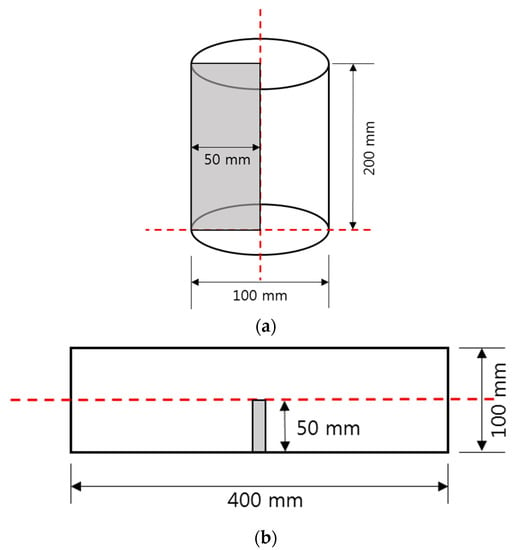
Figure 1.
(a) Cylindrical and (b) cuboid specimens with 50 mm deep notches representative of inactive cracks found in concrete.
For the concrete durability tests, only the cylindrical specimens were used. Specimens were repaired with epoxy, impregnant, or epoxy/impregnant; unrepaired notched specimens were retained as control. Notch widths of 2 and 5 mm, and compressive strengths of 20 and 40 MPa were used. Tests were conducted to simulate carbonation, chloride attack, and freeze–thaw damage. Three specimens were prepared for each combination of variables, giving a total of 144 specimens.
Figure 2 illustrates epoxy, impregnant, and epoxy/impregnant repairs. Epoxy repairs fill cracks; impregnant repairs apply a coating to the concrete and crack surfaces; epoxy/impregnant repairs fill the crack and protect the surface. The epoxy used in this study was a low-viscosity type mainly used for repairing cracks in concrete social infrastructure, such as bridges, tunnels, and dams. It exhibits high physical strength when hardened. Crack injection was performed using a syringe. Impregnant forms additional hydrates and increases the density of micropores inside the concrete by reacting with Ca(OH)2, thus improving the durability. Impregnant was applied to the surface using a brush.
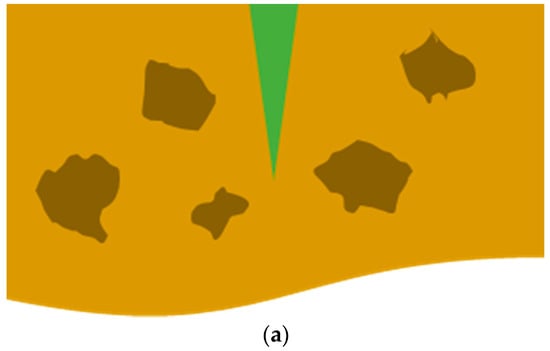
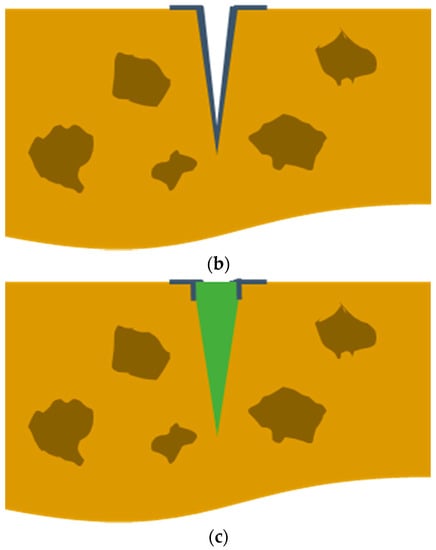
Figure 2.
Crack repairs using (a) epoxy, (b) impregnant, and (c) epoxy/impregnant. The brown backgrounds represent concrete, the green shaded areas represent epoxy, and the blue lines represent impregnant.
2.3. Compressive and Flexural Strength Tests
The compressive strength tests were conducted in accordance with KS F 2405 (standard test for the compressive strength of concrete). The notched concrete samples were prepared; they were repaired using each of the methods under evaluation, and left for a predetermined curing period [24]. Then, the compressive strength was measured using a 200-ton universal testing machine (UTM). The flexural strength tests were conducted in accordance with KS F 2408 and ASTM C 293 (standard tests for the flexural strength of concrete). The square specimens were repaired using the various methods, and the flexural strength was measured using a 5-ton UTM after the curing period [25]. Four-point loading tests were conducted by installing supports at both ends and applying loads at L/3 points. Loading was performed at a rate of 0.01 mm/min using the displacement control method.
2.4. Accelerated Carbonation Test
Durability tests are conducted with various equipment as shown in Figure 3. Figure 3a shows the chamber used for the accelerated carbonation test. The test was conducted in accordance with KS F 2584 (standard test for the accelerated carbonation of concrete) and KS F 2596 (standard test for measuring the carbonation depth of concrete) [26,27]. For the carbonation test and depth measurement, the concrete specimens were left to cure for a certain period after demolding, and were cured again at a constant temperature of 40 °C, humidity of 60%, and CO2 concentration of 5%, in accordance with the standards. After one week and four weeks, the specimens were split using the UTM and sprayed with a 1% phenolphthalein solution to measure the carbonation depth based on the color change. The carbonation velocity with age can be calculated using the measured carbonation depth, and the carbonation depth prediction equation given by
where is the carbonation depth (mm), A is the carbonation velocity (mm/y), and t is the time (year).
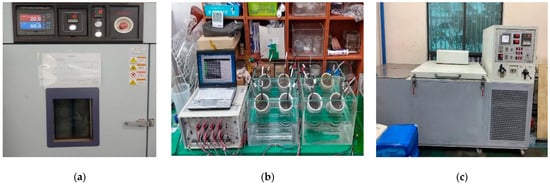
Figure 3.
Experimental set-up: (a) Accelerated carbonation chamber, (b) concrete chloride test, and (c) freeze–thaw chamber.
2.5. Chloride Tests
The chloride ion penetration resistance tests were conducted in accordance with NT BUILD 492 (concrete, mortar, and cement-based repair materials: chloride migration coefficient from non-steady-state migration experiments), as shown in Figure 3b [28]. In this test, three test specimens were cut from a cylindrical specimen at approximately 50 mm intervals. The specimens were subjected to vacuum saturation; then, chloride acceleration tests were conducted using test acrylic cells and a voltage generator with the pressurization voltage set to 30 V, and an application time of 12 h. For the chloride diffusion coefficient measurements, the specimens were split upon completion of the acceleration test and sprayed with a 0.1 N silver nitrate solution. Then, the chloride ion penetration depth was measured. The chloride diffusion coefficient was calculated using the equation
which was specified in NT BUILD 492, using measurements such as the penetration depth, temperature, time, and voltage. Here, Dnssm is the chloride diffusion coefficient in an unstable state, is 1 if the ion is chlorine, F is the Faraday constant, U is the absolute value of the voltage, R is the gas constant, T is the average temperature of the anode solution at the beginning and end, L is the thickness of the specimen, is the chloride ion penetration depth, t is the experimental time, is the error function, is the chloride ion concentration of the part discolored by silver nitrate, and is the chloride ion concentration of the cathode cell.
2.6. Freeze–Thaw Test
Figure 3c shows the chamber used for the freeze–thaw test. These tests were conducted in accordance with KS F 2456 (standard test for the resistance of concrete to rapid freeze–thaw) [29]. One freeze–thaw cycle lasted for 4 h; freezing was performed under atmospheric conditions, and thawing was performed in water between –18 and 4 °C. The test was repeated for 0, 100, 200, and 300 cycles, and the relative dynamic elastic modulus was calculated using the equation
where is the relative dynamic elastic modulus after C freeze–thaw cycles, is the primary resonance frequency after 0 cycles, and is the primary resonance frequency after C cycles. The durability index can then be derived using the equation
where is the durability index of the specimen, P is the relative dynamic elastic modulus after N cycles, N is the number of cycles at which the relative dynamic elastic modulus reaches 60%, and M is the number of cycles when the exposure to freeze–thaw ends. In addition, the compressive strength test was conducted upon completion of the 300-cycle freeze–thaw test to examine the strength reduction rate.
3. Results and Discussion
3.1. Compressive and Flexural Strength
Table 2 and Figure 4 and Figure 5 show the compressive and flexural strength results. The specimens were divided into intact (no notch), notched (unrepaired), epoxy, impregnant, and epoxy/impregnant groups. After 28 days, the compressive strengths of the intact samples with target strengths of 20 and 40 MPa were 21.3 and 39.1 MPa, respectively. For the specimens with a target strength of 20 MPa, those with 2 and 5 mm notches had strengths of 20.1 and 18.8 MPa, approximately 5% and 15% lower than the intact specimen, respectively. Among the repaired specimens, those repaired with epoxy or epoxy/impregnant were approximately 2–5% stronger than those repaired with impregnant. In addition, the difference between the strength of the impregnant and epoxy specimens was greater when the notches were wider. For the specimens with a target strength of 40 MPa, those with 2 and 5 mm notches were approximately 10% and 17% weaker than the intact specimen, respectively. Among the repaired specimens, the epoxy and epoxy/impregnant specimens were approximately 2–5% stronger than the impregnant specimens. When the cracks were narrower, the difference between the strength of the impregnant and epoxy specimens increased [30,31]. When cracks occur in such a way, the concrete performance is degraded, and the epoxy material that serves as the filling has an eminent adhesive strength, so it behaves integrally with the concrete. However, the impregnant material is a coating type and has a lower concrete strength performance than epoxy.

Table 2.
Compressive and flexural strength test results for various concrete specimens.
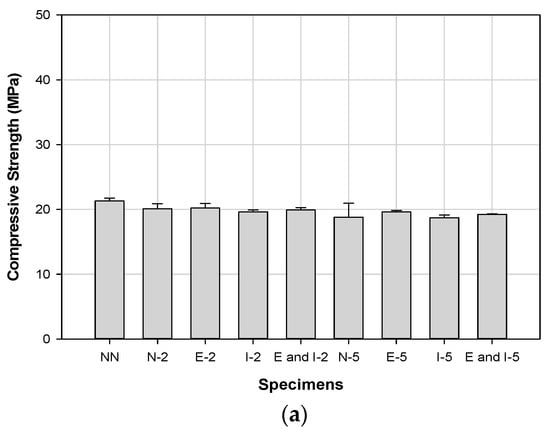
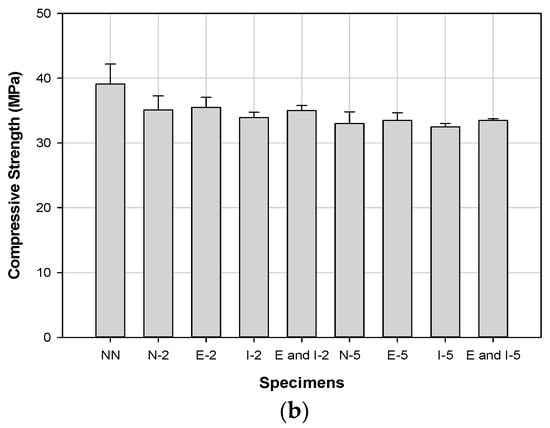
Figure 4.
Compressive strengths of specimens with target compressive strength of (a) 20 MPa and (b) 40 MPa.
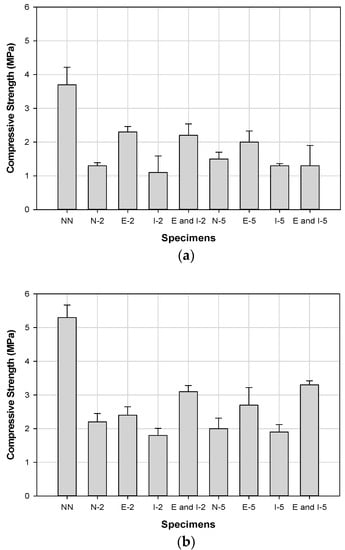
Figure 5.
Flexural strengths of specimens with target compressive strength of (a) 20 MPa and (b) 40 MPa.
The flexural strengths of the intact specimens with target strengths of 20 and 40 MPa were 3.7 and 5.3 MPa, respectively. For a target strength of 20 MPa, the unrepaired notched specimens were approximately 50% weaker than the intact specimen. Among the repaired specimens with 2 and 5 mm notches, the epoxy specimens were approximately 2 and 1.5 times stronger than the impregnant specimens, respectively. For a target strength of 40 MPa, the unrepaired notched specimens were more than 60% weaker than the intact specimen. Among all the repaired specimens, the epoxy specimens were approximately 1.5 times stronger than the impregnant specimens.
These results show that the compressive and flexural strengths of the concrete decreased when there were cracks, and that the epoxy and epoxy/impregnant had clear repair effects. However, the impregnant did not have a significant effect on the strength. Furthermore, the epoxy/impregnant repair had an insignificant effect on the specimen with a target strength of 20 MPa and a 5 mm notch. It is likely that this is because just three specimens were used; such errors may be expected to be reduced if more specimens are used.
As for the strength, the epoxy repair is more effective than impregnant repair and is expected to be effectively applicable to infrastructure such as bridges, roads, and dams on which high loads act.
3.2. Accelerated Carbonation
Table 3 and Figure 6 and Figure 7 show the carbonation depths and velocity rates. The measurements were taken after one and four weeks to examine any changes. The carbonation depths of the intact specimens with target strengths of 20 and 40 MPa were 9.4 and 4.4 mm, respectively. For the repaired specimens with 2 and 5 mm notches and a target strength of 20 MPa, the impregnant specimens exhibited the smallest carbonation depths at one week, 8.7 and 8.9 mm, respectively. However, after four weeks, the epoxy/impregnant specimens exhibited the smallest carbonation depths, 9.9 and 11.7 mm, respectively, approximately 30–50% better than the other repaired specimens. For the repaired specimens with 2 and 5 mm notches and a target strength of 40 MPa, after one week, the epoxy/impregnant and impregnant specimens exhibited the smallest carbonation depths, 2.1 and 1.6 mm and 1.5 and 1.6 mm, respectively. However, after four weeks, the epoxy/impregnant specimens exhibited the smallest carbonation depths, 5.8 and 5.9 mm, respectively, approximately 25% better than the other repaired specimens. The carbonation velocity exhibited similar trends because it was derived using the carbonation depth.

Table 3.
Carbonation depth and velocity rate test results for various concrete specimens.
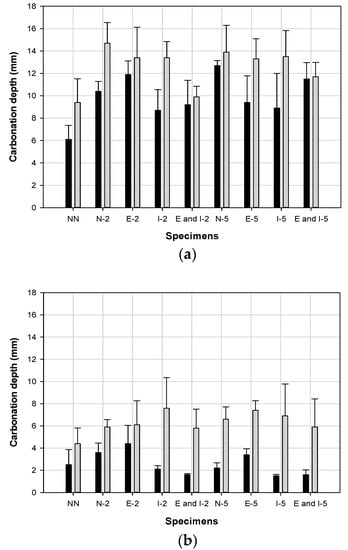
Figure 6.
Carbonation depths for specimens with target compressive strength of (a) 20 MPa and (b) 40 MPa.
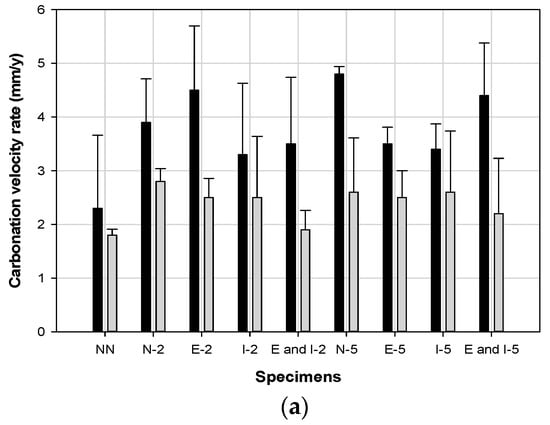
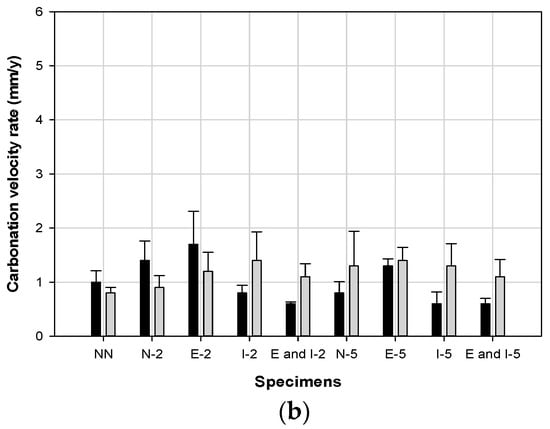
Figure 7.
Carbonation velocities for specimens with target compressive strength of (a) 20 MPa and (b) 40 MPa.
These results show that the carbonation depth decreased as the concrete strength increased [32]. The accelerated carbonation test results confirm that the repair methods that included impregnant, i.e., impregnant repair or epoxy/impregnant repair, were more effective at reducing the carbonation depth and carbonation velocity. However, carbonation depth in the repaired specimens degraded between week one and week four.
As such, for carbonation resistance, it will be more effective in the long term to repair the epoxy/impregnant simultaneously rather than separately. Furthermore, it would be most effective to apply it to roads with high traffic and structures exposed to the atmosphere for a long period of time. If carbon dioxide penetrates along the crack, it causes corrosion of the reinforcing bar, which can reduce the adhesion performance and significantly shorten the life of the structure.
3.3. Chloride
Table 4 and Figure 8 and Figure 9 show the results for the chloride depth and diffusion coefficient. The chloride depths in the intact specimens with target strengths of 20 and 40 MPa were 30.5 and 23.0 mm, respectively. The unrepaired 2 and 5 mm notched specimens with a target strength of 20 MPa had chloride depths of 21.8 and 19.3 mm, respectively. In the corresponding impregnant and epoxy/impregnant specimens, the chloride depths decreased to 9.5 and 7.7 mm, and 10.0 and 9.4 mm, respectively, approximately 3–3.5 times lower than the epoxy specimens. The unrepaired 2 and 5 mm notched specimens with a target strength of 40 MPa had chloride depths of 13.4 and 13.7 mm, respectively. The chloride depths in the corresponding impregnant and epoxy/impregnant specimens were 6.5 and 7.9 mm, and 8.1 and 9.5 mm, respectively, approximately 2–3 times lower than the epoxy specimens. The chloride diffusion coefficient showed a similar tendency as the chloride depth.

Table 4.
Chloride depth and diffusion coefficient test results for various concrete specimens.
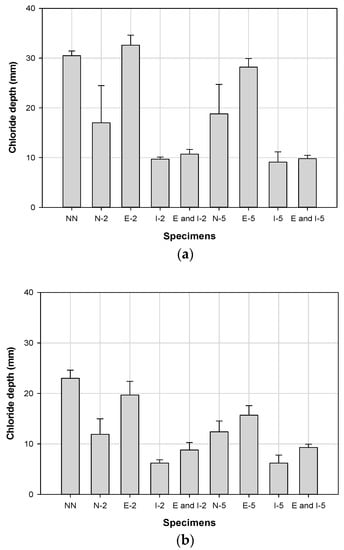
Figure 8.
Chloride depths for specimens with target compressive strength of (a) 20 MPa and (b) 40 MPa.
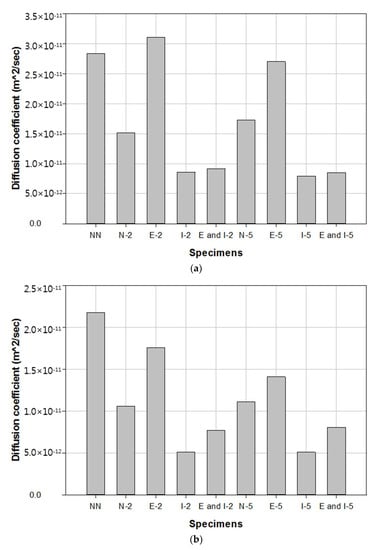
Figure 9.
Chloride diffusion coefficients for specimens with target compressive strength of (a) 20 MPa and (b) 40 MPa.
These results show that the repair methods that included impregnant had more obvious repair effects than the epoxy repair method in terms of the chloride depth. This shows that the use of epoxy alone would not be effective for repairs in chloride-rich environments.
As such, the epoxy effect of chloride is insignificant, but the impregnant effect is pronounced. Impregnant repair will be mainly applicable to areas such as apartments, roads, breakwaters, and offshore structures in coastal areas. If chloride penetrates along the crack, it reaches the reinforcing bars of the structures and causes corrosion of the reinforcing bars, resulting in a decrease in structural performance.
3.4. Freeze–Thaw
Table 5 and Figure 10 and Figure 11 show the concrete relative dynamic elastic modulus and compressive strength results after repeated freeze–thaw cycles. The relative dynamic elastic modulus was measured after 100, 200, and 300 cycles. Assuming that the relative dynamic elastic modulus before the freeze–thaw cycles is 100%, the degradation in the durability performance of the concrete specimens for each repair method can be determined. The relative dynamic elastic moduli of the unrepaired 2 and 5 mm notched specimens with a target strength of 20 MPa were 78.2% and 82.5%, respectively. All the epoxy, impregnant, and epoxy/impregnant specimens exhibited higher relative dynamic elastic moduli than the unrepaired specimens. The reason for this is that moisture moves along the cracks in the non-repair specimen, which easily causes freezing and thawing and lowers the relative dynamic elastic modulus due to poor durability [33]. In particular, the epoxy/impregnant specimens exhibited relative dynamic elastic moduli of approximately 90%, indicating that the structural performance was largely maintained. The relative dynamic elastic moduli of the unrepaired 2 and 5 mm notched specimens with a target strength of 40 mm were 84.9% and 82.7%, respectively. All the repaired specimens showed an improvement in the relative dynamic elastic modulus. In addition, the epoxy/impregnant specimens exhibited better performance than the epoxy and impregnant specimens, reaching 92.2% and 95.4% for 2 and 5 mm notches, respectively. The epoxy/impregnant specimens showed higher relative dynamic elastic moduli at the higher target strength because the modulus is related to the watertightness of the concrete specimens [34]. After the freeze–thaw cycles, the epoxy and epoxy/impregnant specimens exhibited the same results when the target strength was 20 MPa and notch width was 2 mm. Under all other conditions, the epoxy/impregnant specimen exhibited the highest strength, followed by the epoxy and impregnant specimens.

Table 5.
Relative dynamic elastic modulus and compressive strength test results for various concrete specimens.
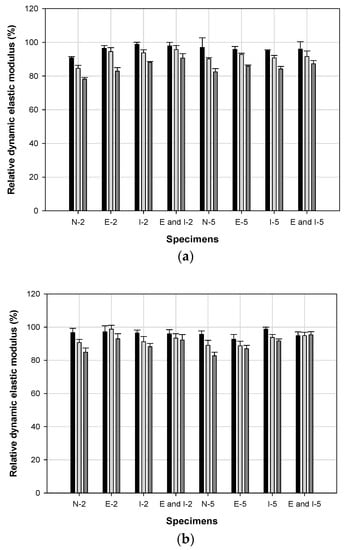
Figure 10.
Relative dynamic elastic moduli of concrete specimens with target compressive strength of (a) 20 MPa and (b) 40 MPa.
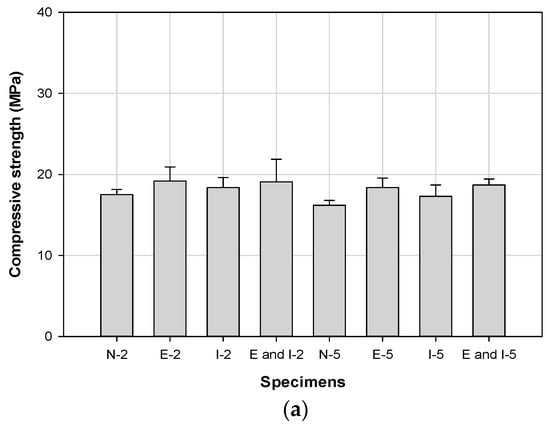
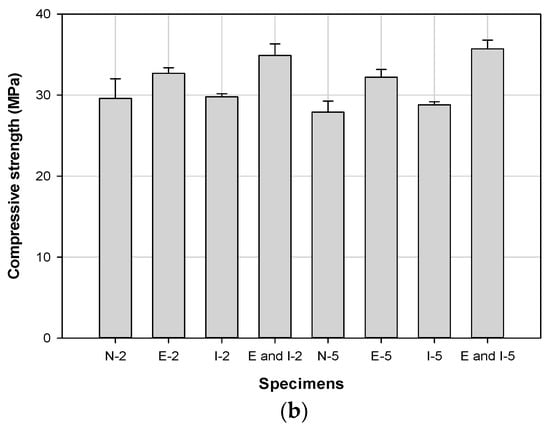
Figure 11.
Compressive strength of concrete specimens with target compressive strength of (a) 20 MPa and (b) 40 MPa.
Freeze–thaw is more severe in areas with a large daily temperature variation, and these results show that all the considered repair methods have significant repair effects in terms of durability. However, in terms of strength, repair methods that include epoxy are most effective.
As described, when a crack occurs in a structure, moisture penetrates along the crack, and when the temperature reduces to subzero, the moisture freezes and the volume expands. As such, repeated temperature changes may occur, and in the end, the structure may be detached and destroyed. Therefore, in this study, in the case of freeze–thaw resistance, epoxy and epoxy/impregnant repair appears to be the most effective. When applied to an actual structure, it would be most advantageous to apply to areas where the minimum temperature drops below zero and the maximum temperature rises above zero repeatedly, and it will also be suitable for mountainous areas and places with heavy snowfall.
4. Conclusions
In this study, compressive and flexural strength tests were conducted while considering the strength and physical aspects of the structure, inactive cracks with different widths, and epoxy, impregnant, and epoxy/impregnant repair methods. Moreover, the durability with respect to carbonation, chloride attack, and freeze–thaw was evaluated. The following conclusions can be made:
- (1).
- Repairs that included epoxy exhibited the highest compressive strength. Specimens repaired using epoxy and epoxy/impregnant were approximately 2–5% stronger than those repaired using impregnant. This is because the epoxy filled the cracks with high adhesion. The flexural strength showed a similar trend.
- (2).
- The carbonation resistance test results showed that impregnant and epoxy had the greatest repair effect after one week, but epoxy/impregnant showed approximately 10% higher performance after four weeks. The performance of the impregnant repair decreased over time, and it is concluded that epoxy/impregnant repairs are most effective for concrete structures exposed to carbonation over a long period of time.
- (3).
- The chloride resistance test results confirmed that repair methods including impregnant had a penetration effect 2–3.5 times greater than the epoxy repair method. This is because epoxy repairs involve penetration at the concrete interface, whereas impregnant blocks chloride penetration from the outside due to its interface protection and waterproofing.
- (4).
- For freeze–thaw, both the relative dynamic elastic modulus and durability index were greater than 80% after 300 cycles when the exposure ended for all the specimens. For impregnant repairs, the relative dynamic elastic modulus exhibited a greater reduction rate as the number of freeze–thaw cycles increased. The reduction rate was low when the cracks were repaired using epoxy or epoxy/impregnant. As for the compressive strength after freeze–thaw, the reduction rate was less than 20% for all the repair methods. The methods that included epoxy were strongest.
- (5).
- As discussed, the crack size is an important factor when concrete structures are repaired. However, the strength and environmental factors also have a significant effect.
The results confirm that epoxy is most effective for strength, epoxy/impregnant for carbonation, impregnant for chloride, and epoxy or epoxy/impregnant for freeze–thaw. To secure more accurate data, more repair materials, methods, and cracks will be examined in future research.
Author Contributions
Conceptualization, T.-K.K. and J.-S.P.; Formal analysis, T.-K.K. and J.-S.P.; Investigation, T.-K.K. and J.-S.P.; Methodology, T.-K.K. and J.-S.P.; Project administration, J.-S.P.; Resources, T.-K.K.; Software, T.-K.K.; Supervision, J.-S.P.; Validation, T.-K.K. and J.-S.P.; Visualization, T.-K.K. and J.-S.P.; Writing—original draft, T.-K.K.; Writing—review and editing, T.-K.K. and J.-S.P. All authors have read and agreed to the published version of the manuscript.
Funding
This research was funded by the Smart Civil Infrastructure Research Program for the Ministry of Land, Infrastructure and Transport of the Korean Government, grant number 17SCIP-B128496-01.
Institutional Review Board Statement
Not applicable.
Informed Consent Statement
Not applicable.
Data Availability Statement
The data presented in this study are available on request from the corresponding author.
Acknowledgments
This research was supported by a grant (17SCIP-B128496-01) from the Smart Civil Infrastructure Research Program funded by the Ministry of Land, Infrastructure and Transport of the Korean government.
Conflicts of Interest
The author declares no conflict of interest.
References
- Mehta, P.K.; Paulo, J.M.M. CONCRETE (Microstructure, Properties, and Materials), 3rd ed.; McGraw Hill: New York, NY, USA, 2006. [Google Scholar]
- Sidney, M.; Francis, Y.; David, D. CONCRETE, 2nd ed.; Prentice Hall: Upper Saddle River, NJ, USA, 2003. [Google Scholar]
- Chang, C.-F.; Chen, J.-W. The experimental investigation of concrete carbonation depth. Cem. Concr. Res. 2006, 36, 1760–1767. [Google Scholar] [CrossRef]
- Khunthongkeaw, J.; Tangtermsirikul, S.; Leelawat, T. A study on carbonation depth prediction for fly ash concrete. Constr. Build. Mater. 2006, 20, 744–753. [Google Scholar] [CrossRef]
- Cho, H.-C.; Ju, H.; Oh, J.-Y.; Lee, K.J.; Hahm, K.W.; Kim, K.S. Estimation of Concrete Carbonation Depth Considering Multiple Influencing Factors on the Deterioration of Durability for Reinforced Concrete Structures. Adv. Mater. Sci. Eng. 2016, 2016, 1–18. [Google Scholar] [CrossRef]
- Han, S.-H.; Park, W.-S.; Yang, E.-I. Evaluation of concrete durability due to carbonation in harbor concrete structures. Constr. Build. Mater. 2013, 48, 1045–1049. [Google Scholar] [CrossRef]
- Silva, R.; Neves, R.; De Brito, J.; Dhir, R. Carbonation behaviour of recycled aggregate concrete. Cem. Concr. Compos. 2015, 62, 22–32. [Google Scholar] [CrossRef]
- Nemecek, J.; Kruis, J.; Koudelka, T.; Krejčí, T. Simulation of chloride migration in reinforced concrete. Appl. Math. Comput. 2018, 319, 575–585. [Google Scholar] [CrossRef]
- Wang, J.; Basheer, P.M.; Nanukuttan, S.V.; Long, A.E.; Bai, Y. Influence of service loading and the resulting micro-cracks on chloride resistance of concrete. Constr. Build. Mater. 2016, 108, 56–66. [Google Scholar] [CrossRef]
- Farahani, A.; Taghaddos, H.; Shekarchi, M. Prediction of long-term chloride diffusion in silica fume concrete in a marine environment. Cem. Concr. Compos. 2015, 59, 10–17. [Google Scholar] [CrossRef]
- Sun, G.W.; Zhang, Y.S.; Sun, W.; Liu, Z.Y.; Wang, C.H. Multi-scale prediction of the effective chloride diffusion coefficient of concrete. Constr. Build. Mater. 2011, 25, 3820–3831. [Google Scholar] [CrossRef]
- Kim, T.-K.; Choi, S.-J.; Kim, J.-H.J.; Chu, Y.-S.; Yu, E. Performance Based Evaluation of Carbonation Resistance of Concrete According to Various Curing Conditions from Climate Change Effect. Int. J. Concr. Struct. Mater. 2017, 11, 687–700. [Google Scholar] [CrossRef]
- Jiang, L.; Niu, D.; Yuan, L.; Fei, Q. Durability of concrete under sulfate attack exposed to freeze–thaw cycles. Cold Reg. Sci. Technol. 2015, 112, 112–117. [Google Scholar] [CrossRef]
- Ma, Z.; Zhu, F.; Ba, G. Effects of freeze-thaw damage on the bond behavior of concrete and enhancing measures. Constr. Build. Mater. 2019, 196, 375–385. [Google Scholar] [CrossRef]
- Ministry of Land, Infrastructure and Transport. Detailed Guidelines on Safety Inspection and Precision Safety Diagnosis; Report No. RD-12-E6-024; Korea Authority of Land & Infrastructure Safety: Jinju, Gyeongnam, 2017. (In Korean)
- Christodoulou, C.; Goodier, C.I.; Austin, S.A.; Webb, J.; Glass, G.K. Long-term performance of surface impregnation of reinforced concrete structures with silane. Constr. Build. Mater. 2013, 48, 708–716. [Google Scholar] [CrossRef]
- El-Hawary, M.; Al-Khaiat, H.; Fereig, S. Performance of epoxy-repaired concrete in a marine environment. Cem. Concr. Res. 2000, 30, 259–266. [Google Scholar] [CrossRef]
- Dai, J.-G.; Akira, Y.; Wittmann, F.; Yokota, H.; Zhang, P. Water repellent surface impregnation for extension of service life of reinforced concrete structures in marine environments: The role of cracks. Cem. Concr. Compos. 2010, 32, 101–109. [Google Scholar] [CrossRef]
- Kim, H.J.; Kim, Y.K.; Kwon, S.J. Evaluation of Durability and Self-clearing in Concrete Impregnated with Photocatalyst-colloidal Silica. J. Korea Inst. Concr. Struct. Maint. Inspe. 2018, 22, 47–54. (In Korean) [Google Scholar]
- Bae, J.S.; Kim, H.J.; Park, G.J.; Han, J.W. A Study on Characteristics of Concrete Impregnated with the Inorganic Surface Penetration Agents. J. Korea Inst. Concr. Struct. Maint. Inspe. 2010, 14, 71–77. (In Korean) [Google Scholar]
- Kwon, S.J.; Park, S.S.; Lee, S.M.; Kim, J.W. Selection of Concrete Surface Impregnant through Durability Tests. J. Korea Inst. Concr. Struct. Maint. Inspe. 2007, 11, 77–87. (In Korean) [Google Scholar]
- Korea Concrete Institute (KCI). Standard Concrete Specification and Commentary; Korea Concrete Institute (KCI): Seoul, Korea, 2009. [Google Scholar]
- Korea Standards Association (KSA). Standard Test Method for Making Concrete Specimens; KS F 2403; Korea Standards Association (KSA): Seoul, Korea, 2019.
- Korea Standards Association (KSA). Standard Test Method for Compressive Strength of Concrete; KS F 2405; Korea Standards Association (KSA): Seoul, Korea, 2017.
- Korea Standards Association (KSA). Standard Test Method for Flexural Strength of Concrete; KS F 2408; Korea Standards Association (KSA): Seoul, Korea, 2016.
- Korea Standards Association (KSA). Standard Test Method for Accelerated Carbonation of Concrete; KS F 2584; Korea Standards Association (KSA): Seoul, Korea, 2020.
- Korea Standards Association (KSA). Standard Test Method for Measuring Carbonation Depth of Concrete; KS F 2596; Korea Standards Association (KSA): Seoul, Korea, 2019.
- Nordtest. Chloride Migration Coefficient from Non-Steady-State Migration Experiments; NT Build 492; Nordtest: Espoo, Finland, 1999. [Google Scholar]
- Korea Standards Association (KSA). Standard Test Method for Resistance of Concrete to Rapid Freezing and Thawing; KS F 2456; Korea Standards Association (KSA): Seoul, Korea, 2013.
- Choi, S.; Lee, K.-M.; Jung, S.-H.; Kim, J.-H. A Study on the Carbonation Characteristics of Fly Ash Concrete by Accelerated Carbonation Test. J. Korea Concr. Inst. 2009, 21, 449–455. [Google Scholar] [CrossRef][Green Version]
- Kwon, S.J.; Park, S.S.; Lee, S.M.; Kim, J.W. A Study on Durability Improvement for Concrete Structures Using Surface Impregnant. J. Korea Inst. Concr. Struct. Maint. Inspe. 2007, 11, 79–88. (In Korean) [Google Scholar]
- Li, Y.; Liu, X.; Li, J. Experimental Study of Retrofitted Cracked Concrete with FRP and Nanomodified Epoxy Resin. J. Mater. Civ. Eng. 2017, 29, 04016275. [Google Scholar] [CrossRef]
- Dong, Y.; Su, C.; Qiao, P.; Sun, L. Microstructural damage evolution and its effect on fracture behavior of concrete subjected to freeze-thaw cycles. Int. J. Damage Mech. 2018, 27, 1272–1288. [Google Scholar] [CrossRef]
- Shang, H.-S.; Yi, T.-H. Freeze-Thaw Durability of Air-Entrained Concrete. Sci. World J. 2013, 2013, 1–6. [Google Scholar] [CrossRef] [PubMed]
Publisher’s Note: MDPI stays neutral with regard to jurisdictional claims in published maps and institutional affiliations. |
© 2021 by the authors. Licensee MDPI, Basel, Switzerland. This article is an open access article distributed under the terms and conditions of the Creative Commons Attribution (CC BY) license (http://creativecommons.org/licenses/by/4.0/).